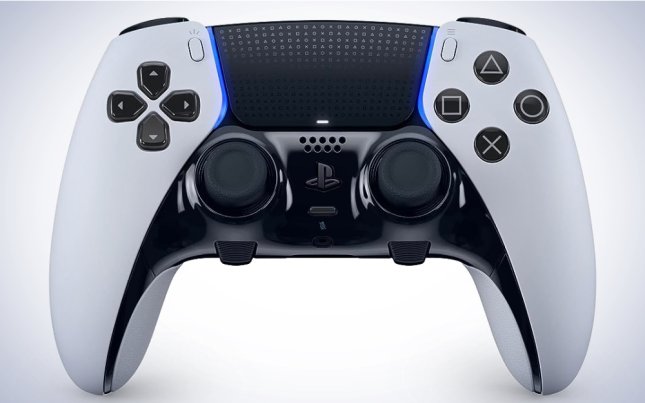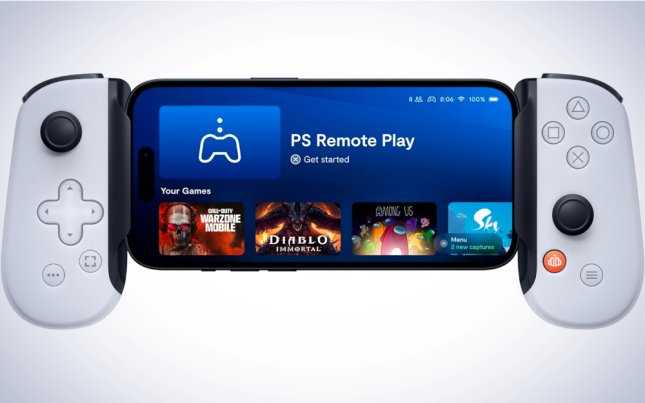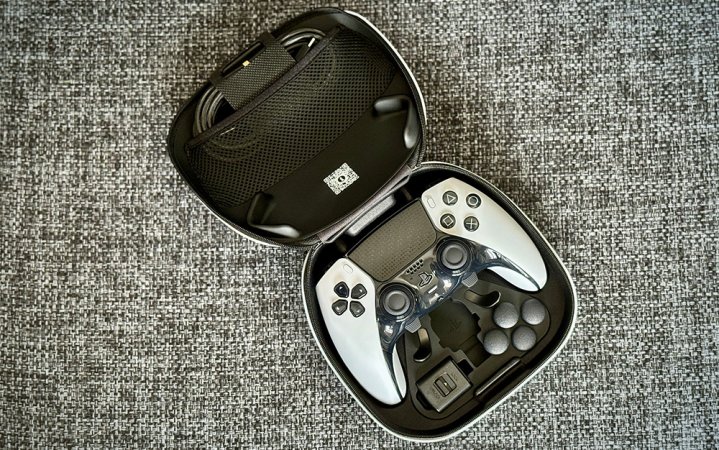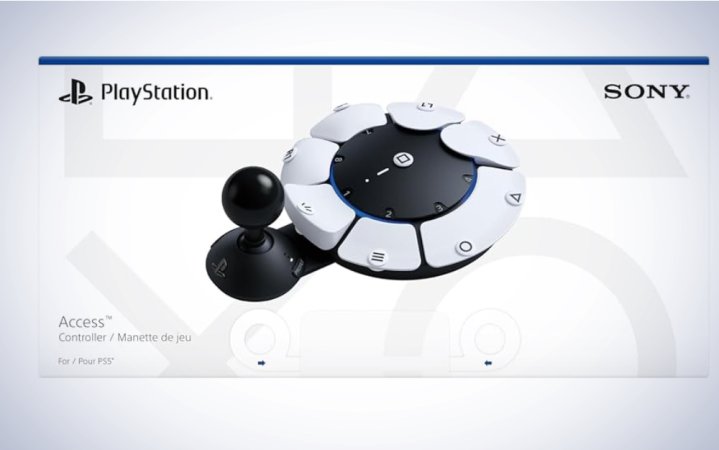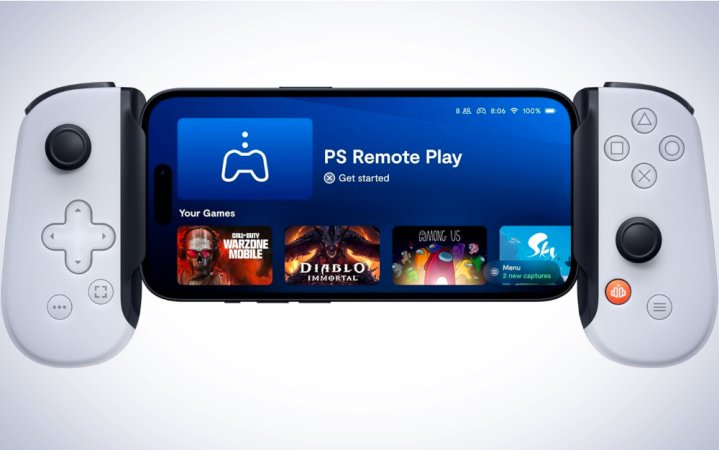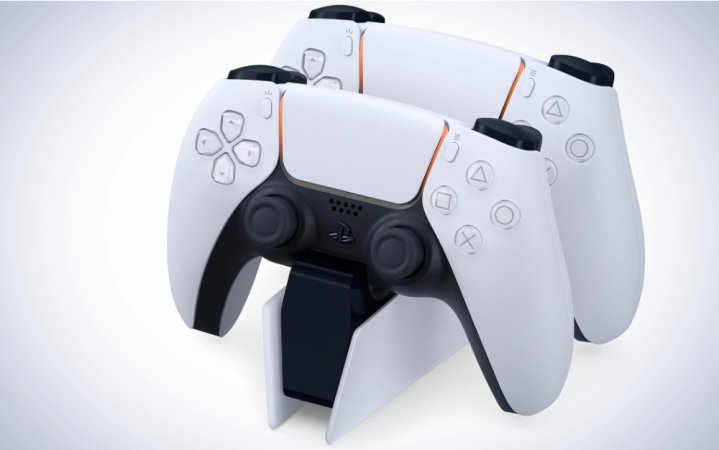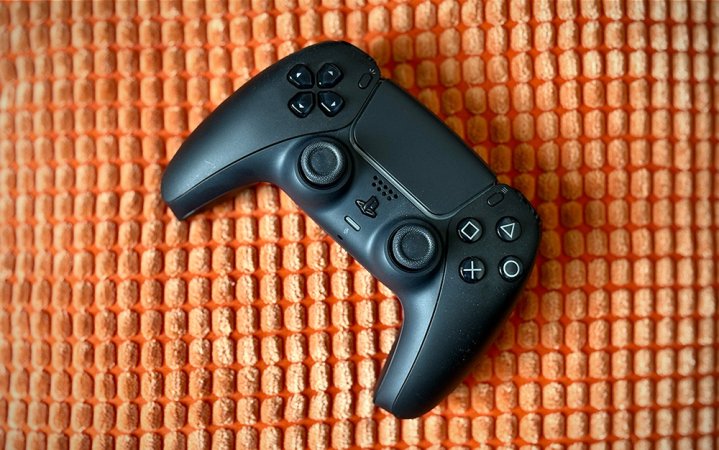We may earn revenue from the products available on this page and participate in affiliate programs. Learn more ›

In 2020, a new generation of home video game consoles was released worldwide, headlined by Sony’s newest PlayStation, the PlayStation 5, and its DualSense controller. Since then, the PS5 has been a bonafide hit, selling over 50 million units in three years. The games, like God of War: Ragnarok, Marvel’s Spider-Man 2, and Baldur’s Gate 3, have been uniformly excellent. But great new graphics and fun gameplay have not been the only selling points for the PS5: The console’s base controller has new and improved features, including adaptive triggers and haptic feedback, that make games more immersive and easier to play than ever. These new features have opened new avenues to gameplay, but the variety of games and gamers has also exploded, meaning specialized controllers are often needed for high-level gameplay in different genres, and gamers with disabilities might need a completely different controller set-up to be able to play games effectively. Luckily, all these situations have been considered by Sony and third-party manufacturers, and there’s a variety of high-quality controllers on the market. We’re here to separate who’s got game from who’s got lame and help you choose the best PS5 controllers in 2024.
- Best overall: Sony DualSense
- Best pro: Sony DualSense Edge
- Best pro alternative: PDP Victrix Pro BFG
- Best fight stick: HORI Fighting Stick Alpha
- Best accessibility: PlayStation Access
- Best remote play: BACKBONE One
- Best accessory: PlayStation DualSense Charging Station
- Best case: SCUF Universal Controller Protection Case
- Best value: Sony DualSense
How we chose the best PS5 controllers
The first thing we considered with our recommendations is the performance of a controller. Does it “feel” right when you are playing? Is it comfortable to hold? When you press a button, does the action happen when it should? There was a time when third-party controllers were largely cheap crap, and basic responsiveness was a huge issue, but that’s no longer the case. The higher-level technology in a PS5 controller has required a lot more care in design and manufacturing of third-party controllers.
Second, we looked at innovation. Do these controllers offer something that no other controllers do? Do they innovate even beyond the base innovations of the PS5 console? There are some impressive designs that Sony themselves haven’t yet embraced, like modular options for replacing controller face components.
Lastly, we looked for value. When two controllers were roughly equivalent in performance and innovation, we went for the cheaper option. Of course, we are considering value and reliability before price, but the truth is that unlike in early generations of the PlayStation, where there were bargain-basement priced controllers that reaffirmed the old adage “you get what you pay for,” most controllers built for the PS5 are pretty high quality and reliable. (Though stick drift—an issue where analog sticks lose their calibration—can still be an issue due to wear and tear.)
The best PS5 controllers: Reviews & Recommendations
Two of the PlayStation 5’s key features are brand new, and they are called adaptive triggers and haptic feedback. “Adaptive trigger” refers to the ability of a game’s programming to change the way the trigger buttons (L2 and R2) on the top of a PS5 controller work. Based on the context of a game, these buttons can be easier or harder to press down, or have “stops” where there are two functions for one button: one if you let go of the trigger before you get to the first stop, which has physical feedback to let you know you’re at it, and another if you press through the stop and press the button all the way down. These features really let you feel the trigger presses in a way that’s never before been possible.
Haptic feedback is the same experience you might have had with the home button on an iPhone in the last several years. The face buttons on a PS5 controller—X, circle, square, and triangle—can, if a game so desires, buzz back at you when pressed (or when not pressed in time), giving you a sensory experience for your thumb that can help you find correct timing and also confirm better when you’ve pressed a button. Our picks offer these and other features suited to different types of games and gamers.
Best overall: Sony DualSense
PlayStation DualSense Wireless Controller
Pros
- Comfortable
- Reliable for most players
- Cool features that enhance gameplay
- Wide variety of colorways
- Seamless integration with PS5 system and games
Cons
- A bit heavy
- Small subset of controllers known to suffer from analog stick drift
- Somewhat short battery life
Specs
- Weight: 15.2 ounces
- Features: adaptive triggers, touchpad, haptic feedback, built-in microphone
- Color Options: white, midnight black, volcanic red, cosmic red, sterling silver, cobalt blue, starlight blue, nova pink, galactic purple, gray camouflage, various game-branded editions (like the Spider-Man 2 PS5 bundle version pictured above)
As has been typical in recent console generations, the best controller for a console is the one that comes with it. In the case of the PS5, that controller is the DualSense. Building upon four previous generations of controller design, the DualSense includes features like the controller rumbling in response to on-screen events, gyro aim (aiming by moving the controller rather than using the stick or directional pad), a button that allows you to share screenshots and videos to social media, and non-slip grips. However, the DualSense goes beyond what the DualShock4 (the PS4’s controller) offered in terms of new features that affect gameplay considerably. Adaptive triggers are a literal game-changer. The back trigger buttons on the top of the controller (L2 and R2) can have less or more resistance when pressed based on game situations. Trying to have your character swing a heavy axe? The trigger might be tougher to press down. Picked up a gun that has a hair trigger? Your trigger will spring back quickly while affording an easy press. There are even moments where there will be a “wall” in the trigger press giving you two different attack options. A light press to the first “wall” produces a light attack, while a heavier press all the way through produces a mightier swing with your sword.
The DualSense also features haptic feedback in the face buttons, something never before seen in PlayStation controllers. Much like the home “button” on older and smaller iPhones—really a haptic feedback sensor—your button may jostle slightly when pressed, if the game programmers wish it to do so. These features really get you into the game in a new and exciting way.
DualSense comes in almost a dozen colors, plus there are limited edition game-skinned controllers released regularly. Marvel’s Spider-Man 2 and God of War: Ragnarok are recent examples, though they are now hard to find. At $70 retail, it’s among the cheapest fully compatible PS5 controllers on the market and can often be found on sale for $50.
There are few drawbacks to the DualSense, though they do exist. The sticks and buttons can develop issues from overuse—if you’re a very heavy gamer, you might want to invest in a “pro” controller built for dozens of hours of use per week. The battery will also dwindle quickly. You’ll want to charge the controllers between play sessions or even during a longer session if you don’t have an extra controller to switch out. However, there’s no better overall controller available for the PS5. Every other controller on this list is for much more narrow needs, while a DualSense leaves nearly everyone satisfied. Whether as a backup controller or for multiplayer, the DualSense is the best overall PS5 controller.
Best pro: Sony DualSense Edge
Sony DualSense Edge
Pros
- High gameplay customizability with trigger length adjustments and mappable back buttons
- Replaceable stick modules allow for less expensive fixes than buying a new controller
- On-controller interface allows more control without having to go to the system menu
- Changeable stick caps can maximize comfort
- Included hard case
Cons
- Expensive
- Most features are unnecessary for all but the most serious gamers
- Only one color option
Specs
- Weight: 2.59 pounds (with case and accessories)
- Features: Changeable stick caps, on-controller interface, replaceable stick modules, adjustable trigger lengths, included USB braided connector with lockable housing, mappable back buttons
- Color Options: White with black touchpad
For truly dedicated competitive gamers, especially those who play first-person shooters, Sony has an upgraded DualSense known as the DualSense Edge. All the features of the base DualSense are present, and the additional features are all about customization, repairability, and competitive edge.
The most noticeable difference, other than the two-color design, is the two analog sticks exist in a replaceable module, and the sticks themselves can be swapped out. You’ll get three stick options: a concave one like the base DualSense and two sets of convex ones of different lengths. You won’t get a replacement module in the box when you buy the DualSense Edge, but you can buy them separately if you start to experience stick drift or lose range of motion on your sticks. Also swappable are the two buttons on the back of the controller, unique to the DualSense Edge. You can slot in a “button” type or a “paddle” type and then map various functions to these new buttons through the DualSense Edge app that will download automatically to your PS5 when you pair the controller.
Another custom feature of the DualSense Edge is the trigger length. You can make a complete “press” shorter than it is with a base DualSense. Once you do this, it will take some getting used to, but a shorter press means faster shots or attacks in a game that uses the triggers as attack buttons (which is a lot of them).
The PS5 app for the DualSense Edge can save multiple settings profiles for multiple games or genres of games, which can be swapped with a single button press on the face of the controller. This saves a ton of time for when you want to switch from a first-person shooter to something like a sports game without having to go into menus and change all the controller settings back to the presets. The entire controller is remappable through the app; even if a game doesn’t have the option, you can put the function of the L2 button on the X button with DualSense Edge.
Lastly, an upgraded cable (braided, unlike the DualSense’s cable) and a hard carrying case offer a better connection and a way to protect and transport your controller. The cable also has a locking mechanism that can be played over it to prevent your controller from becoming unplugged. There is a slight but significant latency difference between a wired USB controller and a wireless Bluetooth controller, and most high-level video game players prefer a wired connection, so the braided cord does more than just charge. Meanwhile, the case is the nicest on the market, and I wish it sold separately for those who don’t want to drop $200 on a single controller.
That $200 really is the biggest drawback of the DualSense Edge. Assuming you want the modded features it offers, it’s the best-quality controller on the market by far, surpassing previous third-party attempts at pro-style controllers. Another minor drawback is despite lots of play customizability, the controller itself is only available in a single colorway: white with black. However, if you want to take your gaming to the next level, or just have a more reliable and versatile controller and don’t mind paying around three times the money of the base controller, the DualSense Edge is the best controller you can get.
Best pro alternative: PDP Victrix Pro BFG
PDP Victrix Pro BFG
Pros
- Can off-set your directional pad and analog sticks
- Can swap out a six-button face set-up for fighting games
- Five different settings for trigger sensitivity
- Even more customizable on PC with downloadable software
- Slightly cheaper than DualSense Edge
Cons
- Remapping is complicated and not software-based
- No built-in microphone
- No adaptive triggers or haptic feedback
Specs
- Weight: 1.18 pounds (controller only)
- Features: Swappable controller face elements allowing for offset directional pad and analog stick, “fight pad” setup for right-side buttons, two d-pad and two analog stick styles, mappable back buttons, adjustable triggers,
- Color Options: Black, black gold, blue camo
When you compare the Victrix Pro vs. the DualSense Edge, you have a case of a very good pro-style controller that offers several key features that the Edge doesn’t have but also lacks several key features that the Edge lacks. It’s hard to recommend the Victrix over the Edge in a vacuum, but to a small subset of gamers who prefer a modular controller with a layout they can easily physically change, the Victrix Pro is their best choice.
Modular design means that you can swap out nearly everything on the Victrix Pro’s face. The position of the left directional pad and analog stick can be swapped to create XBox-style offset sticks. There are two different types of analog sticks and two different types of directional pads to choose from as well. The right side of the face and switch from a stick-and-four-button layout to a six-button layout to turn the Victrix into the best “fight pad” style controller for the PS5. (The second-best, the HORI PlayStation Fighting Commander OCTA, is much cheaper, if you’re looking specifically for a fight pad.) These six buttons are what’s known as “microswitch,” meaning they require much less pressure to register a press than regular buttons, for quicker reactions.
In addition to the modular face, the Victrix has five settings for trigger sensitivity, four built-in mappable back buttons, and PC software that allows for full controller remappability if you connect it to your PC (which, let’s face it, is a drawback compared to the Edge’s PS5 app’s convenience). The back buttons are kind of a pain to map, but once you set them up, they work really well, and you can save three different profiles that are switchable with a button on the face.
What you give up is, sadly, some of the best features of the Edge. The triggers on the Victrix are not adaptive. The face buttons do not give haptic feedback. There’s no onboard microphone. And the PC-based remapping software is not as easy to use and integrate as the Edge’s PS5 app.
However, for gamers who want modularity—and especially those who want to offset their analog sticks—the Victrix can do things the Edge simply can’t, making it our best alternative pro PS5 controller.
Best fight stick: HORI Fighting Stick Alpha
HORI Fighting Stick Alpha
Pros
- Comfortable classic arcade layout
- Good quality Hayabusa buttons and stick
- Easy to open for customization of components or graphic
- Also compatible with PS4 and PC
Cons
- Does not work for non-fighting games (no analog sticks)
- Some serious fighting game players prefer a heavier stick
Specs
- Weight: 3.31 pounds
- Features: Arcade-style layout, touchpad in upper center
- Color Options: Standard, Tekken 8, Street Fighter 6
Certain game genres play better with dedicated controllers, such as driving games or flight simulators, and perhaps the most popular genre that benefits from a dedicated controller is fighting games such as Mortal Kombat 1, Street Fighter 6, and Tekken 8. If you’re serious about thrashing your bros and online randos with your favorite combatant, you’re going to want a fight stick to take you to the next tier of competition.
The Hori Fighting Stick Alpha is the best choice on the market. It has a high-quality yet lightweight construction that works well on a lap or a table. The Hayabusa-brand buttons and stick have good quality, but can be swapped out with top-of-the-line Sanwa parts if needed, as the stick opens easily. The art on the controller face is a bit generic, but is also easily customizable. Tekken 8 or Street Fighter 6 variants are available if you know you want to swear allegiance to the King of the Iron Fists or the World Warriors. If you’re not a fighting pro, however, you don’t want this controller. It truly is only for fighting games—most games would be impossible to control with this stick, as it does not feature a right stick.
If you’re looking for a fight pad, as opposed to a fight stick, HORI also makes the HORI PlayStation Fighting Commander OCTA, which is a really good value at under $55, but like this fight stick is not a suitable controller for non-fighting games, as it lacks a right analog stick. It’s not quite as nice as the Victrix Pro in its fight pad set-up, but it’s less than a third of the price. If you want a dedicated fight stick, however, the HORI Fighting Stick Alpha is the choice for best fight stick PS5 controller.
Also consider: The NACON Daija Arcade Fight Stick is a very nice stick but has placed many function buttons on the right side of the controller housing (including the touchpad), which some may find strange to get used to, and costs 20 to 25 percent more.
Best accessibility: PlayStation Access
PlayStation Access
Pros
- Designed for gamers whose ability to use a traditional controller might be impaired
- Allows for 360-degree orientation
- Can be combined with another Access or DualSense/DualSense Edge to create custom setups
- Saves up to 30 profiles
Cons
- Small parts might be easily lost
- Some game functionality might require a second Access
Specs
- Weight: 2.25 pounds
- Features: Unique customizable design to allow people with physical disabilities to play games they otherwise might have trouble with
- Color Options: White/black
The PlayStation Access is part of an excellent trend in game design and controller design to allow access to the gaming world to a wider range of people with different physical limitations. Games these days tend to allow for a wide variety of difficulty customizations and modifications of control inputs. For example, if rapidly pressing a button is difficult for someone, they can change the required input to holding the button. These are welcome additions for every players, and the Access is an interestingly designed controller that might be a cool curiosity to some and a bridge to finally gaming the way they want for another.
The key selling point of the Access is how customizable it is. The buttons and stick have different sizes, styles, and contours, and the buttons themselves tend to be very large, allowing for those with limited precision in their mobility to still reliably enter inputs. PS5 software for the Access allows for up to 30 profiles for different games to be saved, and even the stick placement can be changed up to 360 degrees. This is key if you need to place the controller on something like a wheelchair tray, and there’s even the option to attach it to an AMPS mount. A second Access and a DualSense or DualSense Edge can be paired with the Access to create larger set-ups. There are four inputs to add even more peripherals that may be designed for specific players’ needs. The Access is forward-thinking, adjustable, and created with the goal in mind of allowing more people the opportunity to enjoy the world of video games.
If this sounds like it’s not for you, it probably isn’t! But for some, the Access is exactly what they need, and for others it allows them the creativity to create an interesting gaming experience. Ever wanted to set up a big controller that you can place on the floor and play with your feet? The Access makes doing just that relatively simple. Or you could set up your DualSense to accept the movement inputs and your Access to accept the button inputs, and hand the Access to your friend so you can play in tandem. The possibilities are endless and, for some, highly necessary. That makes the PlayStation Access the best accessibility PS5 controller.
Best remote play: BACKBONE One
BACKBONE One Mobile Gaming Controller
Pros
- Seamless integration with PlayStation’s Remote Play app for Android or iOS
- Versions available both for older iPhones (lightning cable) and newer iPhones or Android (USB-C)
- Can connect to your mobile devices as a USB controller
- Can be used and charge the phone at the same time
- Works as a controller for iOS and Android games with controller compatibility
Cons
- Controller lacks the kind of weight that gives it a feeling of quality
- You must remove your phone’s case to connect it to the controller
- Clunkier and less comfortable than Sony-made (and twice as expensive) competitor PlayStation Portal
Specs
- Weight: 10.5 ounces
- Features: Play PS5 games via Remote Play on your phone
- Color Options: White, black
Remote Play is a feature that has existed in PlayStation consoles for a while. It lets you stream a game from your console to your phone via the Internet. Like most game-streaming experiences, the bandwidth required is pretty high, and PlayStation 5 doesn’t offer cloud streaming, you are streaming from your system. This means that your console has to be on and connected to the Internet for you to be able to use Remote Play.
It’s a bit complicated, but feels like magic when it works. While it’s possible to use the Remote Play app on your phone or tablet with a touch-controls overlay, this is a pretty painful experience and makes playing any game that requires quick hand and finger movements all but impossible, limiting you to things like turn-based RPGs, non-real-time strategy games, and visual novels. However, with the BACKBONE One, a direct-connection accessory that turns your phone into a controller with a screen at the center, you’ll be able to more closely approximate the console gaming experience, since you’ll have analog sticks, triggers, and face buttons.
BACKBONE isn’t the only way to do this—you can use almost any Bluetooth controller, including the Sony DualSense itself, to play games via Remote Play—but it does it in a way that feels most comfortable, especially if you want to use Remote Play while out of the house. Your smartphone will turn into something close to a Nintendo Switch in portable mode. There are two models of the BACKBONE One, lightning cable connections for older iPhones, and a USB-C model for the newest generation of iPhones and Android devices. There are also two colors: black and white. Once you’ve secured your phone inside the BACKBONE—which requires the phone’s case to be removed—there’s no need to adjust any settings; it will automatically default to PlayStation controls. At this point, the biggest impediment to your gaming experience will be your Internet speeds. If you’re not on the same wireless network as your PS5 (i.e., if you’re not playing from home), you’re going to need really strong upload speeds at home and really good download speeds wherever your phone is. 5G may not be enough to get an optimal experience.
If this all sounds like something you don’t need—you don’t want to keep your PS5 turned on when you’re not home, you don’t want to monopolize your phone with playing PS5 when you’re away—then it probably isn’t. But if you like the idea of being able to transform your phone into an on-the-go version of your home PS5 and you have the technology and Internet speeds to manage, it’s a really cool, fun feature.
The main drawbacks of the BACKBONE are the feel of the buttons—they don’t have the same texture, weight, or give as a DualSense and take some getting used to—as well as the lack of adaptive triggers and haptic feedback, and the fact that your phone must be out of its case to use it. These are relatively minor quibbles, but the feel of the buttons in particular might be enough for you to want an alternative.
Sony recently released the PlayStation Portal, which looks like most of a DualSense controller with a screen grafted into it. The PlayStation Portal offers a better Remote Play experience, but costs twice as much as a BACKBONE One (assuming the BACKBONE One isn’t on sale), and the screen may not be as nice as your phone’s. What’s pretty great is with the PlayStation Portal, you get adaptive triggers and haptic feedback on the buttons, which are absent in the BACKBONE One. The PlayStation Portal is often out of stock everywhere, and new shipments disappear as soon as they’re available, so it may not be something you can reliably acquire until later, if you’re interested. Therefore, availability, price, and convenience make the BACKBONE One the best remote play PS5 controller.
Best accessory: PlayStation DualSense Charging Station
PlayStation DualSense Charging Station
Pros
- Charge up to two controllers independent of the PS5
- Controllers are corralled in a compact way with a flat bottom, making them easier to manage
- Style of charging station matches PS5 and DualSense controllers
- Small and inexpensive
Cons
- Only holds two controllers
- May not work with all third-party controllers
Specs
- Weight: 12.7 ounces
- Features: Remote charging
- Color Options: White
As soon as you get a second controller, and certainly as soon as you get a third, you’ll start to realize that one of the best benefits of having multiple controller is that when you’re gaming solo and your controller’s battery starts to dwindle, you don’t have to put your gaming on hold while it charges or get closer to the TV and plug in to keep gaming. You can simply switch your controller out for one that’s recently recharged. It’s a freeing experience, let me tell you!
But once you have two or more controllers, you have to deal with the mess of controllers and cords and all the things that make maintaining a neat and tidy workspace or entertainment area in the modern world annoying. The solution is PS5 accessories—specifically a charging station, a place for your controllers to rest in a compact way while being able to simultaneously recharge.
There are several third-party versions of this kind of product, but Sony’s is the best. It’s small, matches the style of the PS5 and DualSense perfectly, and can be placed on an end table next to your couch or chair and plugged in discreetly from the PS5, meaning you both don’t have to get up to switch controllers—one point for laziness—and you can use your USB ports in your PS5 for something other than charging gables—one point for versatility.
Beyond that, controllers click into this charging station in a satisfyingly snug way. The charging speed is just as fast as through the console. The only drawback is that the charging station only holds two controllers, though that’s true of nearly every third-party model as well. It’s not a particularly expensive or large peripheral, so if you have three or more controllers, it’s easy to buy a second charging station. For ease of use, functionality, and convenience, the PlayStation DualSense Charging Station is the best PS5 controller accessory.
Best case: SCUF Universal Controller Protection Case
SCUF Universal Controller Protection Case
Pros
- Compatible with PS5 controllers but also multiple other consoles’ controllers
- Durable hardshell construction
- Soft, protective inner layer
- Fits well in a backpack
Cons
- Just a case
- Colors options are uninspired
Specs
- Weight: 5.64 ounces
- Features: Hardshell case, soft lining, universal compatibility shape
- Color Options: Black, light gray
It’s scary to put a controller in a backpack. It’s really, really easy for an analog stick to snag on something, get bent the wrong way, and develop a defect. If you’re someone who has a really nice pro controller like the Victrix or SCUF’s own Reflex Pro, which would be our third choice in best pro PS5 controller, you’re especially going to want to protect if you’re taking it out into the world. And with the DualSense also being an excellent Bluetooth control for PC, you might own one as a companion to your gaming laptop. So you want to cradle your controller in a plush, loving case. Or at least keep it safe.
Your best option for that situation is the SCUF Universal Controller Protection Case, not just if you have a PS5 controller, but any close-to-standard gamepad. This case works with third-party USB/Bluetooth controllers for PC, Xbox controllers, and Switch Pro controllers as well. It’s a simple, well-made product. The hardshell case, just large enough to fit any of the compatible controller types inside, has a plush inner lining, and a little space to store a USB cable, and that’s it. But zipping your controller up in this case is such a better option than letting it sit naked inside your bag, so the SCUF Universal Controller Protection Case is absolutely the best PS5 controller case you can buy.
Best value: Sony DualSense
PlayStation DualSense Wireless Controller
Pros
- No better controller exists on the market for cheaper
- Access to next-gen controller tech like adaptive triggers and haptic feedback
- Comfortable hand fit
- Wide variety of colors
Cons
- Not much choice at the low-cost end of PS5 controllers as it is
- Can develop stick drift
- Battery life is relatively short
Specs
- Weight: 15.2 ounces
- Features: Adaptive triggers, touchpad, haptic feedback, built-in microphone
- Color Options: White, midnight black, volcanic red, cosmic red, sterling silver, cobalt blue, starlight blue, nova pink, galactic purple, gray camouflage, various game-branded editions
I tried, reader, I did. I tried to find a controller cheaper than the DualSense and that offered at least close to what the DualSense does. But I have to report that controller just does not exist. Perhap because of the amount of innovation in the PS5 controller, or Sony limiting the number of licenses it gives, the only third-party controllers that are compatible with all PS5 games start from $40 more expensive. The only cheaper controller, the HORI Fighting Commander OCTA, is only suitable for fighting games, as it has no right stick, which would make it unable to interact properly with a huge number of games. In the case of PS5 controllers, the best choice in most situations is also the most economic choice. So it all comes back to the advice I gave at the beginning: if you just want another controller, you should be buying a DualSense. The only question is what color.
What to consider when choosing a PS5 controller
The first thing to ask yourself is if you need a controller for a specific purpose, or just another controller in general. If it’s the latter, get a DualSense. It’s that simple. There is no cheaper, better controller for PS5 than the DualSense. Every other controller or accessory on this list exists to fulfill a specific need, rather than just to provide a second controller for multiplayer or a backup in case you run out of battery or a controller breaks. So, need “a” controller? Get a DualSense.
If you have a specific use in mind, then follow the categories. The only real decision left is what kind of pro controller you value. If you like the layout of the standard DualSense, the DualSense Edge is the upgrade you want. If you feel like the physical design of the DualSense is holding your game back, the modularity of the Victrix will hopefully solve that problem.
Otherwise, you’re looking at a fighting stick for fighting games, a PlayStation Access—unlike anything else on the market—for accessibility, and a BACKBONE One for remote play (but only if you have a high-quality smartphone, otherwise wait for the PlayStation Portal to become more available). You can even attach a keyboard and mouse, if you’re looking for alternate inputs.
It’s either a testament to the quality of the products on the marketplace or a result of Sony making a controller that’s too complicated technologically to effectively knock off that there’s simply not a huge number of fully PS5-compatible controllers out there. The ones that are out there are mostly excellent, but cheap controllers are usually only compatible with PS4 games on PS5 because they lack the advanced features necessary for the PS5. In a way, it’s nice to not have to worry about a huge number of choices, but in another way you wish at least one company would try to push Sony to innovate even more in the next generation. Perhaps the Victrix’s modularity will do just that.
FAQs
They can. It’s a relatively rare problem, but it does exist and is extremely annoying when it happens. The only guaranteed way to fix a stick drift-affected controller is to send it to Sony for repairs, but this is long and not free, so sometimes getting a replacement controller is the better option.
The Access controller, build for accessibility, offers the ability to use two Access controllers and a DualSense controller together. The Victrix Pro is modular, so while that’s not an upgrade, it can be modified. The DualSense Edge can’t be upgraded, but its parts can be replaced. There are some aftermarket accessories for the standard DualSense and DualSense Edge to give it better performance, such as a DualSense Edge battery pack or rubber skins for DualSense, but a lot of these products are very niche.
Naturally, this comes down to personal choice, but I’d go with either the white, which matches the PS5 console’s color design, or the midnight black, which is a pleasing matte color that looks exceptionally cool when the touchpad lights up.
Absolutely. There’s no “standard design” PS5 controller for less or the same cost as the DualSense that’s worth getting, frankly, when the DualSense exists. It’s simply a wonderfully designed controller that feels great to use.
Yes, this is one of the big innovations in the PlayStation’s fifth generation. The adaptive trigger technology allows the shoulder buttons (“triggers”) to require different amounts of pressure to be pressed down, depending on what in-game actions are being performed. Playing through Astro’s Playroom, Sony’s free downloadable game-slash-tech-demo, really gives you a sense of what these triggers can do to gameplay.
Sony recommends taking the following actions before sending a controller with stick drift in for repairs: update system and controller software, reset the controller, disconnect and reconnect the controller to Bluetooth, adjust the triggers by using the Trigger Effect Intensity settings on your PS5, and clean the analog stick and its base. If you’ve done all this and you still experience stick drift, the only options are to replace or repair the controller.
Final thoughts on the best PS5 controllers
- Best overall: Sony DualSense
- Best pro: Sony DualSense Edge
- Best pro alternative: PDP Victrix Pro BFG
- Best fight stick: HORI Fighting Stick Alpha
- Best accessibility: PlayStation Access
- Best remote play: BACKBONE One
- Best accessory: PlayStation DualSense Charging Station
- Best case: SCUF Universal Controller Protection Case
- Best value: Sony DualSense
There’s not a ton of choice in the landscape for best PS5 controller, nowhere near what there is in PS5 headsets, but there is a ton of quality. While prices overall aren’t particularly low, the DualSense often goes on sale for $45 or $50, so if you’re not in the market for a new controller at this very instant, it can be beneficial to wait around for a discount. When it comes to specialty controllers, you’re not often going to see big discounts, so if that’s your target, I’d say buy right away to enjoy the benefits of the controller. Every controller and accessory on this list is a solid purchase, assuming you have the need for it within your gaming habits.

